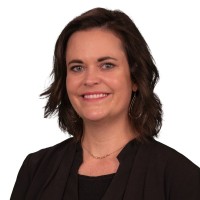
We recently brought you CMO challenges for 2024 related to data, AI, and sales and marketing collaboration, as articulated by Blue Cross Blue Shield of North Carolina CMO and CSR Officer Kelly Calabria. Below is part two of our chat with the marketing chief, which covers the evolution of the healthcare business post-pandemic, new channels the brand is pursuing to reach audiences and how regional targeting will factor into its marketing strategy.
Chief Marketer: A lot has changed in the past few years for healthcare companies after COVID. How has your business evolved?

Kelly Calabria, CMO and CSR Officer at Blue Cross Blue Shield of North Carolina: I think about it in two buckets. The first is around talent. The pandemic has opened up so many opportunities to push and think beyond the talent that might have been accessible to you in the past. So for our organization, we have a hybrid flex model for our work. That means we gather and come together for big, meaningful meetings. It might be a strategy session, an all-hands meeting, town halls and other things, as we gather as a full company.
Adopting this has allowed us to open up our effort to recruit talent from different markets, experiences, industries and places across our state, North Carolina. That has been a real game changer. It’s allowed us to bring in folks that have had different experiences, and it’s also helped us cultivate new paths for employees. The pandemic changed the game on how you think about your talent pool and your talent mix on your teams.
The other one is—because in my role, I’m not just marketing, I also have corporate social responsibility under my purview—the pandemic pushed us through all that we navigated through the George Floyd murder and the things that we went through during those years and continue to learn from, is the importance and necessity of being authentic in the way we talk and interact with each other.
The sentiment of it is so important, because as a brand, you don’t have an option anymore but to stand for something. And if you don’t stand on the right side, it’s hard. Brands are having to make hard decisions, but I think that it matters to people. The pandemic has pushed all of us, whether from how we talk about mental health to different challenges, it’s important that you understand the need for authenticity. And that leads to personalization. One of the things that we’ve been looking at through our advertising spend is how do we incorporate more niche advertising, as we work to understand our audiences better so that they’re being served advertising that is more relevant to them, not just cookie-cutter brand messaging that we’ve had in the market in the past.
CM: Let’s drill down to channels and platforms. Are there any new ways you’re using to reach audiences?
KC: We haven’t really done this yet, but it is on my list for figuring out in ’24: embracing and leveraging TikTok in different ways. I think it’s a miss, even from a B2B perspective, not to be thinking about it as a platform. How are you leveraging it to build those authentic relationships? And listen, as a health insurer, that’s not an easy task. You can’t get on there and [post] five reasons you need health insurance. That’s not going to fly on TikTok. You have to have a strategy, and we’re thinking through that right now. It has a lot of potential, given the algorithm and the targeting.
The other one is, there’s a lot of different test-and-try opportunities for generative AI. For us, one of the areas that we’re looking at is self-service. We do a of template creation, so how do we get to a self-service model where we can cut some of that down to free up time to focus on the big emotional creative? The third is getting local. It’s how we are showing up in all corners of our state. People across our state consume media in lots of different ways. So one of the things we tried and tested during open enrollment this year is leveraging linear radio to see how we can connect with audiences that have bandwidth and broadband issues. It is a huge issue in North Carolina, particularly in our rural parts—and 80 counties out of our a hundred are designated rural. How can we connect in more trusted ways than just relying on digital and social, when they don’t necessarily have stable broadband use?
So we’re looking at all different types of unexpected ways that we can show up local. How are we embedding into our communities more? This year we at Blue Cross we have a county engagement team; we are embedding people who have grown up in those communities and live there currently. We’ve hired them to be Blue Cross on the ground so that we can make sure we’re staying in touch and connected, and understand what the issues and challenges are—so that any solutions we bring are relevant to those that we serve.
CM: Any other thoughts on how you’re using data to drive your business goals?
KC: We want to make sure that it’s not just the media that we’re placing, but also, how are we listening? I don’t know about you, but when I read an interesting post that might be slightly controversial, the first thing I do is go to the comments. How are we getting better at those conversations that are happening outside of the paid media or the advertising we’re placing in the market? How are we getting better at understanding the sentiments of those types of conversations? Because while it’s a little harder to track, you have to be listening and watching it. You can find so many nuggets; it can inform what it takes to resonate with your audience and build that emotional connection with them over time.
CM: How are you are addressing the industry’s current measurement challenges?
KC: For us, it’s moving away from clicks, impressions, likes—all of that—to, how are we getting better at understanding cost-per-lead, cost-per-sale, the interaction of our content to conversion to retention? How are we looking at attribution? We are taking a deeper dive into that. The other thing that we’re looking at, is as we work to stand up our corporate social responsibility function, we building out a purpose framework. Our purpose ends with the statement, “We will not stop until healthcare is better for all.” When you think about that, how do you know you’re making healthcare better for all? We’re taking a hard look at the things that go into that, over 10, 20, 30 years, that [help us] demonstrate that we’ve lived into that in intangible ways. Is it through improved health outcomes? Is it by lowering cost? What are the things that we’re looking at that are significant that can ladder up to saying, “Look what we did. We worked with communities to improve health for all.”
We all have purpose statements. We all say we have something we’re working to live into. The point we’re trying to make is, how do you tangibly prove it? That may mean you need third-party partners to validate. Everything needs to be on the table to be able to credibly show it. Back to that authenticity point, with your consumers and your constituents. How do you really prove it out, and it’s valid? That’s what we’re working towards.